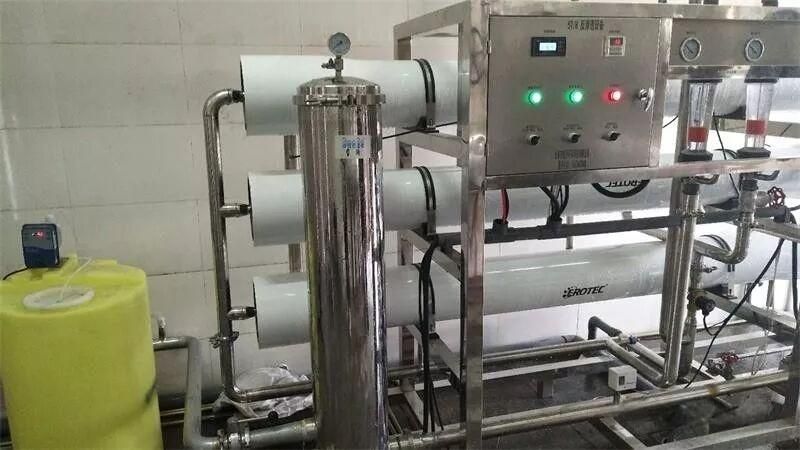Marketing Hotline:
(+86)0532-88988868
(+86)0532-88988868
Reverse osmosis equipment is currently the most widely used desalination technology for producing pure water. The separation targets of reverse osmosis equipment are mainly ions and organic substances in the solution. At present, reverse osmosis equipment represents the most advanced membrane separation technology in today’s society. The principle of reverse osmosis equipment is that, under the action of pressure higher than the osmotic pressure of the solution, substances that cannot pass through the semi-permeable membrane are separated from water. Due to the small pore size of reverse osmosis membranes (approximately 10 angstroms), it can remove inorganic salts, bacteria, microorganisms, viruses, colloids, organic substances, and more from water.
The main causes of reverse osmosis membrane pollution include three categories: physical pollution, chemical pollution, and organic pollution. Physical pollution refers to the deposition and clogging of membrane pores caused by metals (such as iron, manganese, and metal oxides), non-metals (such as CaCO3, CaSO4, BaSO4, which are less soluble non-metallic salts), and colloidal pollutants (such as silica) on the membrane surface. Chemical pollution refers to harmful chemical components adsorbed onto the membrane pores. Organic pollutants are formed by the adhesion of bacteria, slime, fungi, and organic matter on the membrane surface and inside the membrane pores. Among the substances that can cause reverse osmosis membrane pollution, pollutants, especially organic substances, lead to a decrease in flux and separation capacity due to their adsorption on the membrane surface and inside the membrane pores, which is the main reason for the decline in membrane flux. However, the flux decline caused by membrane pollution is often mixed with the reversible flux decline caused by concentration polarization phenomenon, further reducing the membrane separation effectiveness.

1. Suspended Solids
Suspended solid pollutants are commonly found in surface water and wastewater sources, with particle diameters often greater than 1 micron. These impurities can completely settle when the water flow is in a non-turbulent state. They can be easily filtered out by fine sand filters and multimedia filters set up by reverse osmosis equipment. When flocculants or coagulants are applied in the pretreatment system of reverse osmosis equipment, these impurities can also be adsorbed by the flocs formed by the flocculants and subsequently filtered out by multimedia filters or sand filters.
2. Colloidal Pollutants
Colloidal pollutants are also commonly found in source waters of surface water and wastewater, with particle diameters often less than 1 micron. These impurities do not settle freely even when there is no water flow agitation, and they remain in a suspended state. Such impurities may consist of monomer compounds made of organic or inorganic components, or they may be composite compounds made of multiple types of compounds, such as silicate compounds, iron-aluminum oxides, sulfides, tannic acid, humic substances, etc.
3. Biological Pollutants
Biological pollutants are also commonly found in surface water or wastewater. When treating these water sources, the pollution often first becomes evident at the membrane elements at the front end of the reverse osmosis equipment, where an increase in pressure is observed. Initially, the desalination rate of the reverse osmosis equipment may increase due to this phenomenon; however, as the membrane system continues to operate, biological pollution will gradually spread throughout the entire reverse osmosis equipment, leading to widespread membrane fouling. When the membrane system experiences biological clogging, it ultimately causes a significant increase in operating pressure and a decrease in water production. These types of pollutants usually include bacteria, biofilms, algae, and fungi. When designing reverse osmosis process systems, it is essential to pay attention to controlling the activity of the source water. If the bacterial content in the source water exceeds 1000 cfu/100 mg, measures for removal must be considered in the design.
4. Organic Pollutants
The composition of organic matter in raw water is the most complex, making the pollution and impact on reverse osmosis membrane components very difficult to predict. This indicator is a primary pollutant that needs to be seriously considered for protection when designing reverse osmosis equipment. The sources of organic pollutants are generally divided into two types: one type is natural humic organic matter formed from the decay of plants and animals, the other type is organic matter created from industrial waste pollution. When organic matter contaminates reverse osmosis membranes, it is often more firmly adsorbed onto the membrane surface, making cleaning more difficult. Generally speaking, the consequences of organic matter pollution on membrane systems are the hardest to predict: some organic substances in the water may cause almost no damage to the reverse osmosis membrane, but there are individual trace organic substances that, once adsorbed on the membrane surface, can not only contaminate the reverse osmosis membrane but can also lead to degradation and deterioration of the membrane. Therefore, we must pay great attention to the organic matter present in the raw water. Thus, in principle, when designing reverse osmosis equipment, if the raw water TOC (Total Organic Carbon) content reaches 3 mg/l, corresponding removal measures must be considered within the system. Generally, in the reverse osmosis pretreatment system for surface water and wastewater, efforts should be made to remove or decompose most organic pollutants during the pretreatment processes such as coagulation, clarification, and oxidation. If the reverse osmosis equipment's inlet requirements are still not met after these treatments, further removal can be considered through the use of activated carbon adsorption filters, organic pollutant cleaners, or ultrafiltration equipment to ultimately meet the inlet requirements of the reverse osmosis equipment.


